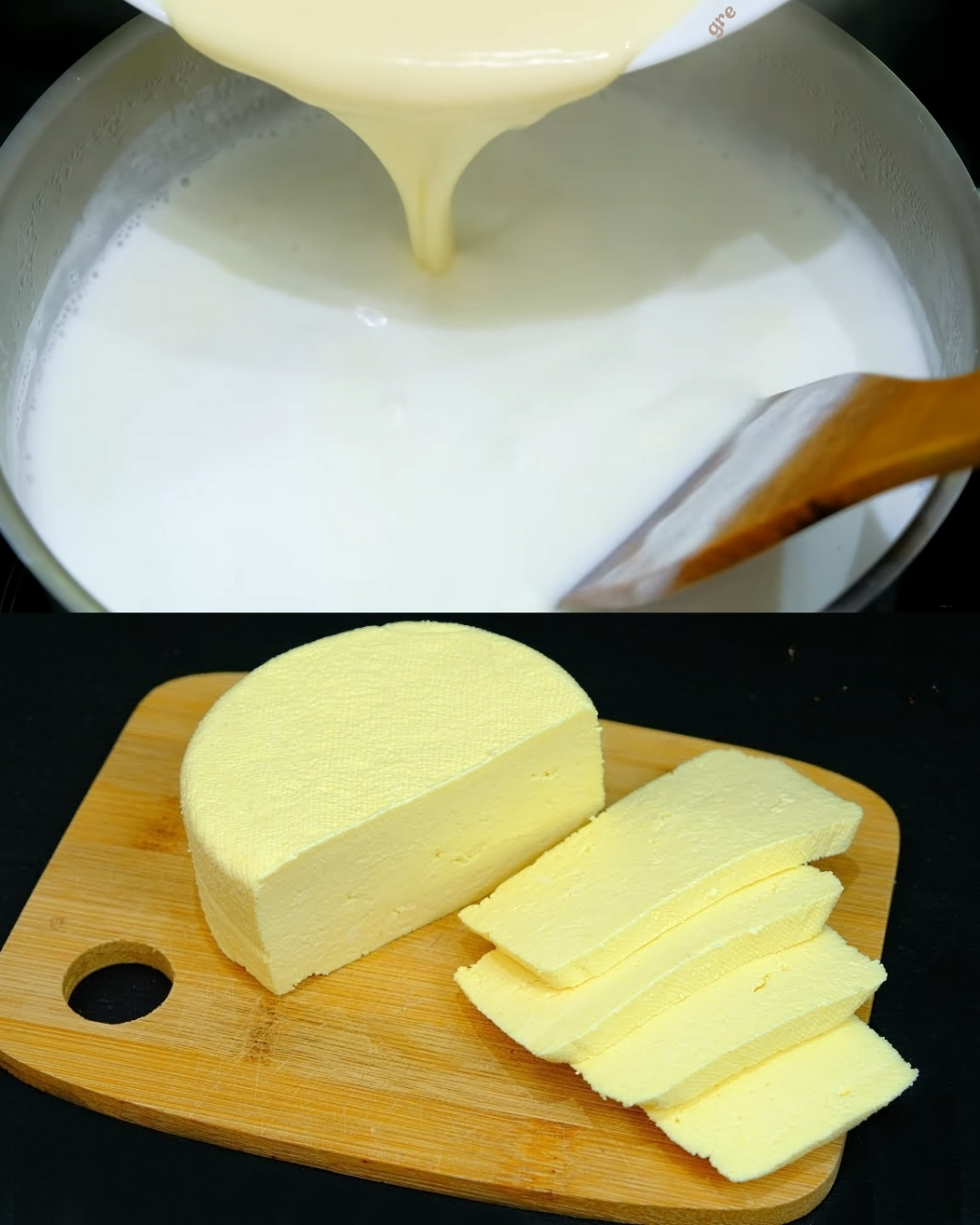If you’ve ever wanted to make your own cheese but were intimidated by rennet, bacterial cultures, or complex aging processes, this simple homemade cheese recipe is the perfect place to start. Using just milk, eggs, and sour cream, you can create a soft, creamy cheese with a delicate texture and mild, fresh flavor — all in under an hour.
This method of cheese-making is based on traditional home techniques from Eastern Europe and Russia, often used to create fresh farmer’s cheese for daily meals. What makes this cheese special is its light, custard-like texture and how incredibly easy it is to make with everyday kitchen tools. No special ingredients, no fancy molds — just comfort, tradition, and deliciousness.
Cooking Time
Preparation Time: 10 minutes
Cooking Time: 15 minutes
Draining and Cooling Time: 2–3 hours
Total Time: Approx. 3 hours (including draining)
Ingredients
-
1 liter milk (3.3% fat or higher)
-
3 eggs
-
200 g sour cream (20% fat)
-
Salt, to taste
Step-by-Step Cooking Directions
-
In a large pot, pour the milk and add salt to taste. Bring the milk to a gentle boil over medium heat, stirring occasionally.
-
While the milk heats, whisk the eggs and sour cream together in a bowl until smooth.
-
Once the milk begins to boil, slowly pour in the egg and sour cream mixture, stirring constantly.
-
Cook over medium heat for 5–7 minutes, occasionally stirring, until the mixture curdles and whey begins to separate.
-
Continue cooking for another 3–5 minutes until large curds form and the whey is mostly clear.
-
Line a colander with two layers of cheesecloth or gauze and pour in the curdled mixture to drain.
-
Let drain naturally, or cover with gauze, place a saucer on top, and set a small weight (around 1 kg) to press the cheese and remove excess liquid.
-
Optionally, transfer the cheese into a homemade mold (like a holed can) to give it a more uniform shape.
-
Allow the cheese to cool to room temperature, then refrigerate.
-
Once firm, unmold and slice — enjoy your fresh homemade cheese!
Nutritional Information (per 100g serving)
-
Calories: 180 kcal
-
Protein: 10–12 g
-
Fat: 12–15 g
-
Carbohydrates: 2–3 g
-
Calcium: High
-
Cholesterol: Moderate due to egg content
-
Sodium: Depends on added salt
The Origins and Popularity of the Recipe
This type of homemade cheese has roots in Eastern European cuisine, where making dairy products from scratch was a common household task. In Russian, Ukrainian, Polish, and Balkan kitchens, simple cheeses were made using milk combined with fermented dairy like kefir, yogurt, or sour cream — and occasionally eggs — to form a soft curd cheese that could be eaten fresh or lightly aged.
Known for its minimal ingredients and clean taste, this cheese is experiencing a resurgence among home cooks seeking natural, preservative-free alternatives to store-bought products. Videos like the one you’ve described are spreading across platforms like YouTube, TikTok, and Instagram, making traditional cheese-making accessible to all.
Reasons Why You’ll Love the Recipe
-
Beginner-friendly: No rennet, thermometers, or complex steps required
-
Quick: Ready within a few hours from pot to plate
-
Customizable: Add herbs, spices, or even nuts to the mix
-
Budget-conscious: Just 3 ingredients that are readily available
-
Versatile: Great on toast, with fruit, in salads, or baked into dishes
-
Healthier option: No preservatives or artificial additives
Health Benefits
This cheese is naturally rich in protein and calcium, supporting muscle health and strong bones. Using full-fat sour cream adds beneficial fats, while eggs bring additional protein and essential nutrients like choline and vitamin D.
Homemade cheese is free of stabilizers and emulsifiers found in many commercial options. You also control the sodium level, making it suitable for those on low-salt diets. Plus, it contains beneficial probiotics if you use cultured sour cream.
Serving Suggestions
-
For breakfast: Spread on toast with jam, honey, or sliced cucumbers
-
With tea or coffee: Enjoy plain or lightly salted for a savory snack
-
As a spread: Mix with herbs like chives or dill and serve on crackers
-
In salads: Crumble over leafy greens, roasted veggies, or cold pasta salads
-
In baked goods: Use it in pastries, cheese rolls, or savory pies
Common Mistakes to Avoid
-
Using low-fat milk or sour cream: These may not curdle properly and yield less cheese
-
Not stirring enough: Can cause milk to burn or curds to clump unevenly
-
Overcooking: This can make the cheese rubbery instead of soft and tender
-
Not draining well: Insufficient draining leads to a watery or mushy cheese
-
Skipping the weight: Pressing helps the cheese firm up and hold its shape
Pairing Recommendations
-
Breads: Rye bread, sourdough, or crisp crackers
-
Fruits: Grapes, apples, figs, or berries for contrast
-
Drinks: Herbal teas, fresh juice, or dry white wine
-
Spreads: Honey, fruit preserves, or herb-infused olive oil
-
Condiments: Dijon mustard or tzatziki for savory options
Cooking Tips
-
Use whole milk for best flavor and yield
-
Stir constantly while adding the egg-sour cream mix to prevent clumps
-
You can flavor the curds during cooking with caraway seeds, smoked paprika, or chopped herbs
-
Reuse the leftover whey in pancakes, soups, or for kneading bread
-
For a firmer cheese, let it drain longer or leave overnight in the fridge under weight
Similar Recipes to Try
-
Homemade Ricotta Cheese
-
Paneer (Indian Fresh Cheese)
-
Labneh (Yogurt Cheese)
-
Quark Cheese (German Soft Cheese)
-
Farmer’s Cheese with Kefir or Lemon Juice
Variations to Try
-
Herbed cheese: Add finely chopped dill, parsley, or chives before pressing
-
Spicy cheese: Mix in chili flakes or black pepper
-
Garlic-flavored: Stir in roasted garlic or garlic powder
-
Smoked version: Use smoked paprika or liquid smoke flavor
-
Dessert version: Add honey and vanilla extract for a sweet cheese spread
Ingredient Spotlight: Sour Cream
Sour cream is the key to this cheese’s creamy texture and delicate tang. With a fat content of 20% or higher, it contributes richness and helps create the gentle curd structure. Unlike lemon juice or vinegar, which produce a firmer, crumbly texture, sour cream allows for a more velvety, soft cheese ideal for spreading or slicing. For best results, choose a high-fat, cultured sour cream with a thick consistency.
Conclusion
Making your own cheese might sound complicated, but with this easy 3-ingredient recipe, you can create a delicious, creamy, and preservative-free homemade cheese in just a few hours. With nothing more than milk, eggs, and sour cream, you’ll be amazed at how rewarding and simple the process can be. Whether you’re enjoying it for breakfast, entertaining guests, or just exploring new cooking techniques, this recipe is one you’ll want to keep in your culinary repertoire.
Once you try this, chances are you’ll never look at store-bought cheese the same way again. It’s customizable, wholesome, and above all — it tastes like home.
Frequently Asked Questions
1. Can I use low-fat milk or sour cream?
It’s not recommended. Low-fat versions won’t curdle as well and will result in much less cheese. Use full-fat milk and sour cream for best texture and yield.
2. Can I skip the eggs?
The eggs are essential for binding the curds and giving the cheese its tender, sliceable consistency. Without them, the cheese may fall apart.
3. How long does homemade cheese last?
Stored in an airtight container in the refrigerator, it will last 4–5 days. Because it contains no preservatives, it’s best eaten fresh.
4. Can I freeze this cheese?
Freezing isn’t ideal as it changes the texture. However, if necessary, freeze in small portions and thaw in the refrigerator before use.
5. Is this cheese suitable for lactose-intolerant individuals?
It depends on the individual. While curds contain less lactose than milk, this recipe still retains some. Use lactose-free milk if needed.
6. Can I use yogurt instead of sour cream?
You can try using thick, full-fat Greek yogurt, but sour cream is preferred for a smoother curd and better flavor.
7. What kind of mold or press can I use?
A DIY mold using a can with holes and a fitted lid works great. A cheesecloth-lined bowl with a weight is also sufficient.
Advertisement
8. What should I do with the leftover whey?
Whey is packed with nutrients. Use it in baking, smoothies, soups, or as liquid in bread dough.
9. Why is my cheese rubbery?
This usually happens from overcooking. Stick to the suggested cooking times and use moderate heat.
10. Can I make this cheese in larger batches?
Yes, just scale the ingredients proportionally. Use a larger pot and mold for bigger quantities.

